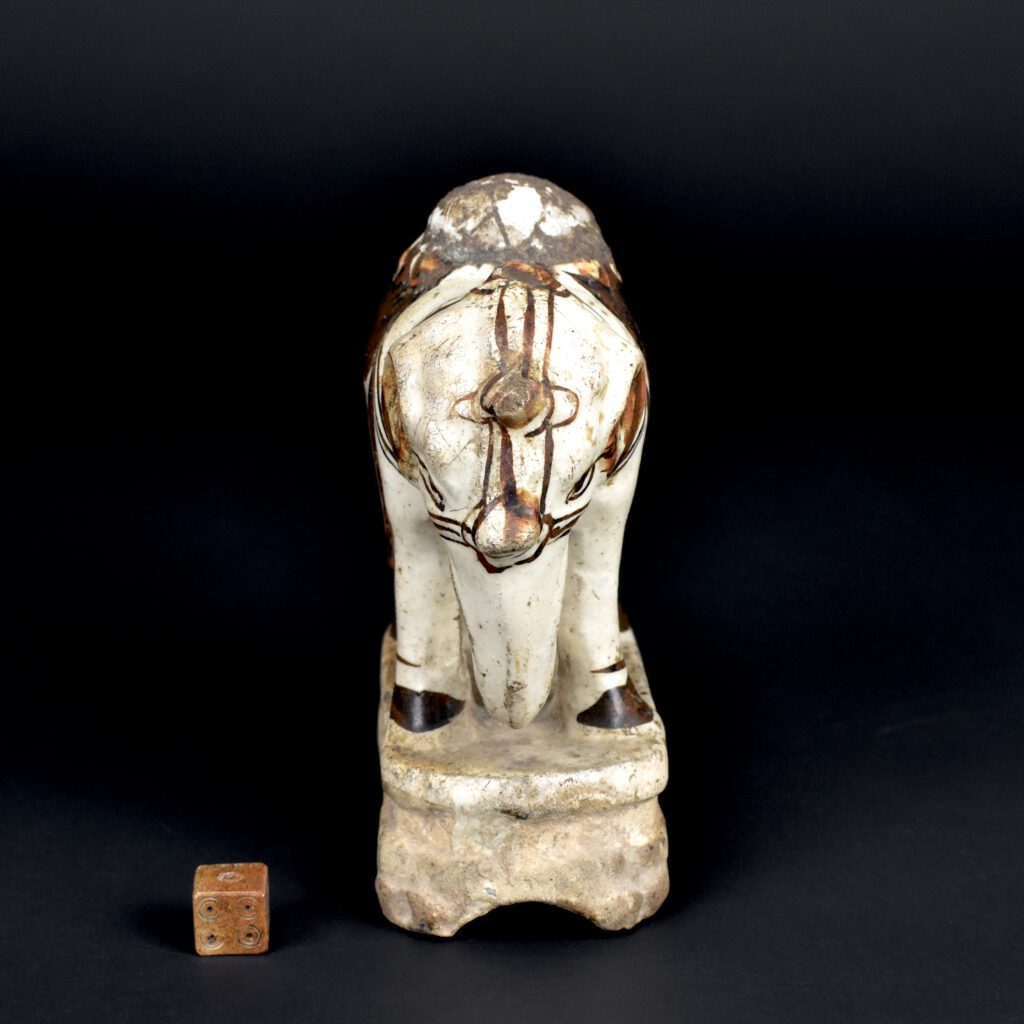
Ming Cizhou Type Stoneware Model of an Elephant
A Small Ming Cizhou Type Painted Model of an Elephant, 16th Century, Probably Jiajing or Wanli c.1550 – 1600. This small model of an elephant is painted in iron-oxide over a cream slipped ground, the thin glaze stops above the lower part of the base, which four feet. This unusual model is incomplete, there would have been a decorative element on the elephants back in the form of a lotus flower, perhaps it was an incense or candle stick holder. Such objects were used on family or temple shrines.
The name Cizhou originated from the ancient area of Cizhou, encompassing a broad arc across China, which was first recorded during the Sui dynasty (581-618). However, the location constantly shifted and though the area of Cizhou is mentioned in the Tang dynasty (618-906) and Five Dynasties (906-960), each referred to an altered location. During the Song, Jin (1125-1234), Yuan (1279-1368), and partly into the Ming dynasties (1368-1644) the kiln areas of Cizhou were primarily concentrated in the northern provinces of Hebei, Henan, and Shaanxi.
See below for more photographs and references.
SOLD
- Condition
- Poor, the top is missing, it was probably an incense or candle stick holder, which would have been of lotus form. You can see its lotus petal edge on the top of the elephant. The missing section has been hidden with a painted plaster like material. There is a crude repair to the outside of part of the base, below the elephants back left leg.
- Size
- Height 11.7 cm (4 1/2 inches). Length 10.6 cm (4 1/4 inches).
- Provenance
- Nicholas de la Mare Thompson (1928-2010).
- Stock number
- 26661
Information
Elephants / Xiang :
Although symbolically important the elephant is not commonly depicted on Chinese ceramics. When it is the depiction, unlike so many animals, it can look unreal and rather odd. Presumably this is because the ceramic artist would have been unfamiliar with an animal, their numbers became diminished and were limited to certain areas of the country. It is thought that China`s elephant population is only in the region of 300 today. The Asian Elephant (Elephas Maximus) is sometimes depicted on Chinese ceramics as an animal with a rounded back and with lose fitting skin, but it can be shown as a powerful animal decked in rich cloth and carrying a vase on it`s back. Like so many other Chinese symbols the meaning it conveys is connected with the pronunciation of the word. Xiang (elephant) is a homonym for the word happiness. A rebus is formed when an elephant is depicted with a rider, usually a child, this conveys a `wish for happiness`. An elephant with a vase forms a rebus meaning `perfect peace in the universe`, this is expanded if there is a saddle cloth to mean `perfect peace and harmony in the universe`. The elephant is also closely connected with the Buddhist religion. An uncommon but interesting image of an elephant can be found on a few pieces of blue and white porcelain from the Transitional period. These scenes depict the Buddhist ritual of washing an elephant. For a Transitional blue and white brushpot dating to c.1640 with a version of this scene see : Late Ming, Chinese Porcelain from the Butler Family Collections (Exhibition catalogue, Sir Michael Butler, Musee National d`Histoire et d`Art Luxembourg 2008. ISBN 978-2-87985-029-0) page 125, plate 86. Another blue and white porcelain Transitional brushpot shows a boy with a brush cleaning the elephants back, see : Seventeenth-Century Blue and White Porcelain and Copper-Red and Their Predecessors (Exhibition Catalogue, S Marchant & Son, London, June 1997) page 53, plate 30.
A Kangxi Blanc de Chine Porcelain Elephant
Robert McPherson Antiques, Sold Archives 25282.









